6 Healthcare Insights from Q2 2023 and What They Mean for You
May 23, 2023
The healthcare job market loosened this quarter as the sector experienced increased hiring despite fewer job openings. Ultimately, as the job market cools it will lead to a decline in the rate of wage growth, especially for hospitals and physicians’ offices. Office visits continue to climb while Personal Consumption Expenditures (PCE) for physician services has reached above average rates, indicating demand for healthcare is rising. Concurrently, remote patient monitoring is becoming increasingly popular with consumers and providers. The rise of the remote health trend is leading to an active M&A environment, as activity in Q1 2023 moved higher and is expected to increase further.
1. The healthcare job market is becoming more favorable for employers
The number of healthcare job openings (in blue) continues to decline while hiring (in purple) continues to rise. With quit rates virtually unchanged, the healthcare labor market is becoming increasingly looser, a benefit for physician practice owners and management.
Healthcare Jobs
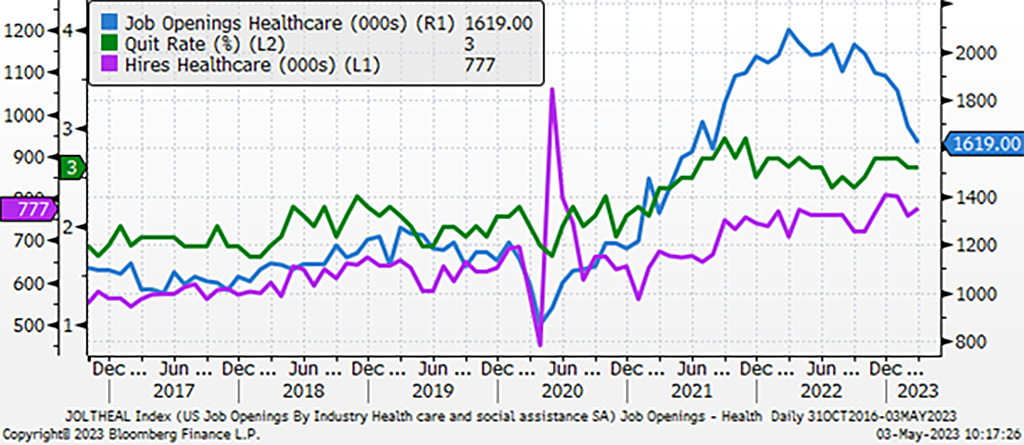
Key takeaway: A more robust healthcare labor market should benefit healthcare providers as they manage overhead costs. Due to fewer job openings and a vibrant job demand, providers may be able to negotiate fairer wages for current and new staff.
2. Looser labor markets are pressuring healthcare wages
Driven by looser labor conditions, the rate of healthcare wage growth has started to decline after hitting historical highs. Wage growth for outpatient care centers remains elevated, however for hospitals and physicians’ offices, wage growth is reverting to near normal levels.
Wage Growth
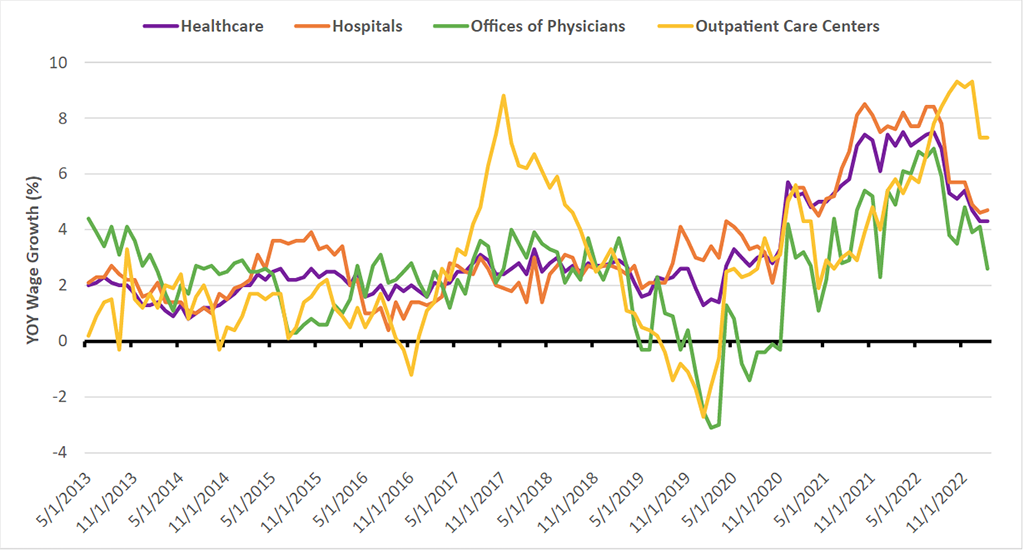
Key takeaway: A looser labor market provides employers with better negotiating leverage to balance employee wage demands, helping to mitigate inflation. If looking to hire new staff, focus on wage growth trends and the decreasing supply of healthcare jobs in your negotiations to manage overhead expenses.
3. The number of visits to the physician’s office continues to climb at a fast rate
Physician office visits in 2023 continue to climb at a faster rate than pre-pandemic rates as healthcare demand rises. This trend reinforces that demand for healthcare is likely to stay elevated as the pandemic has patients more conscious about their health.
Patient Visits
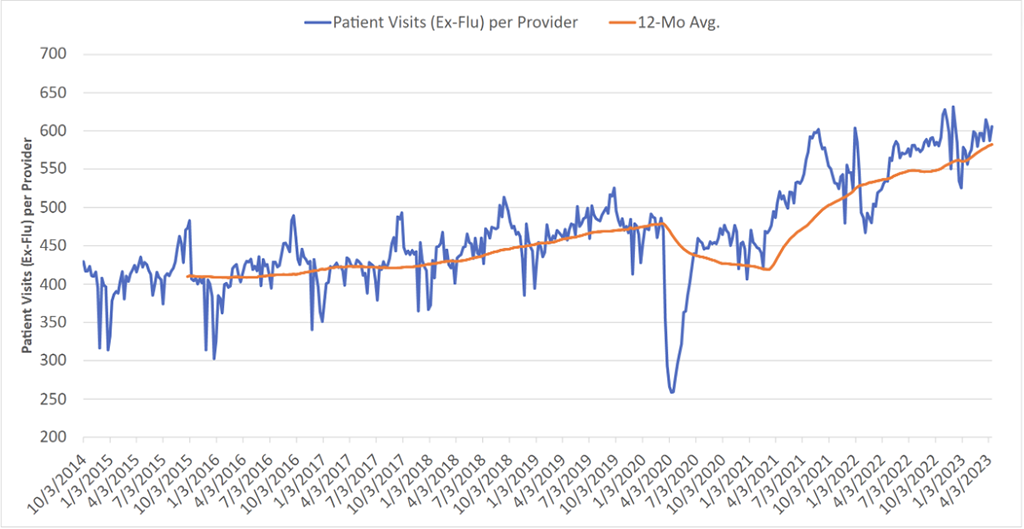
Key takeaway: With the pandemic leaving people more attuned to preventative healthcare, expect the number of patient visits to remain elevated. To accommodate the higher demand, look for ways to affordably scale your practice. For example, employing more technology, such as telehealth, and hiring staff at more competitive wages, given the more favorable job market conditions.
4. The cost for physician services continues to climb at above average rates
For patients, healthcare costs are increasing at faster rates. Personal Consumption Expenditures (PCE) for physician services is accelerating as demand for physicians also rises.
PCE for Physician Services
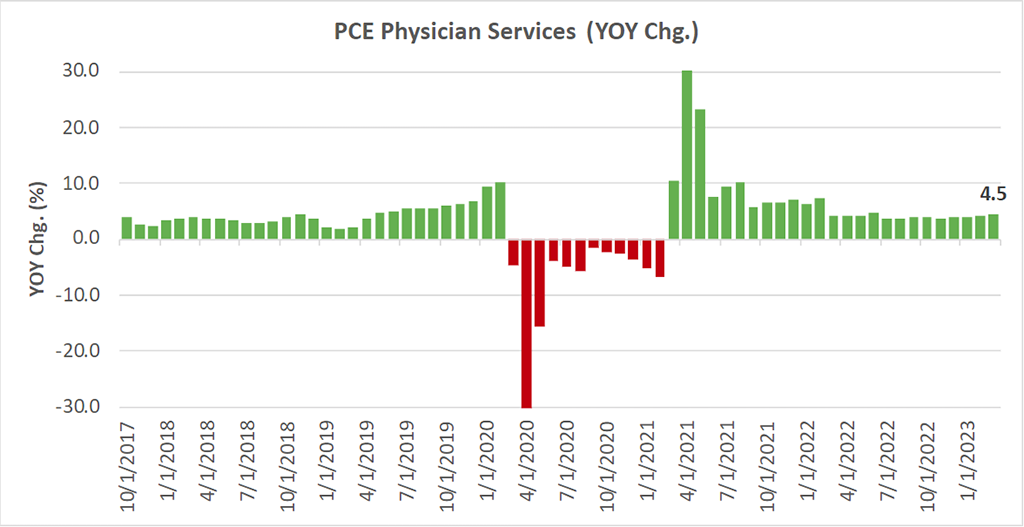
Key takeaway: PCE for physician services indicates a high demand for physician services, yet also poses a risk for collections. With high deductible health plans and other out of pocket expenses, healthcare costs are rising quickly while real wages for consumers struggle, potentially leading to patients failing to pay their bills. Now is the time to focus on collections and alternative payment plans, such as programs that provide credit options, for patients.
5. Interest in remote patient monitoring continues to rise
With the exponential growth of mobility-driven technology, interest in remote patient monitoring has steadily risen and is currently at peak interest. Consumers and providers are becoming more tech-enabled and data-orientated, driven by the growth of “wearables.”
Google Trends: Remote Patient Monitoring
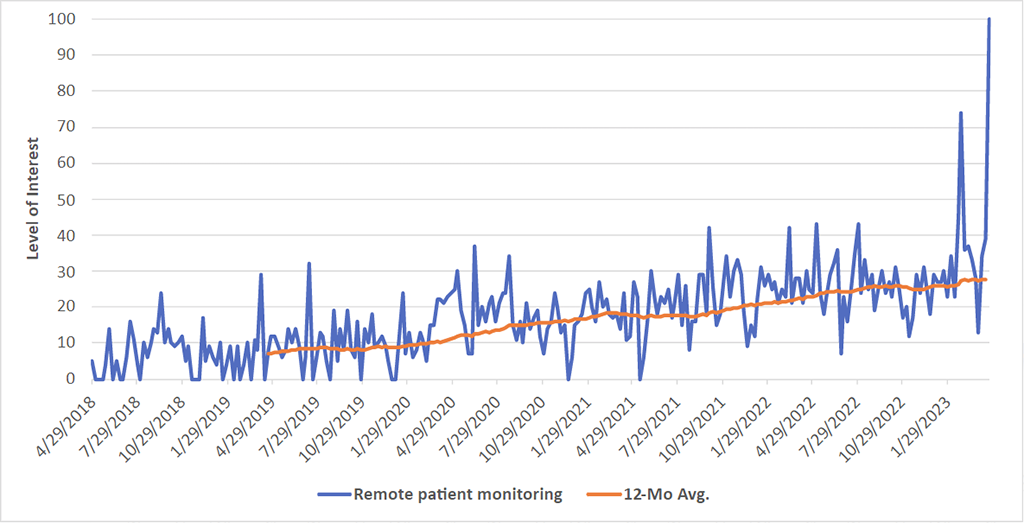
Key takeaway: Consumers have become increasingly more health conscious and data-orientated as technology, such as wearable smart watches, provide real-time analysis of basic health metrics. To keep up with this demand, improve the quality and scale of your practice, engage your patients more deeply and incorporate more remote patient monitoring tools for applications, such as blood-glucose monitoring and remote sleep studies.
6. M&A activity in the healthcare space ticked up in Q1 of 2023
The pandemic brought a surge in healthcare M&A activity in 2021, and then subsided in 2022. With healthcare conditions returning toward normal, despite economic uncertainty and more expensive deal financing, we believe M&A activity will grow higher in 2023.
M&A Activity
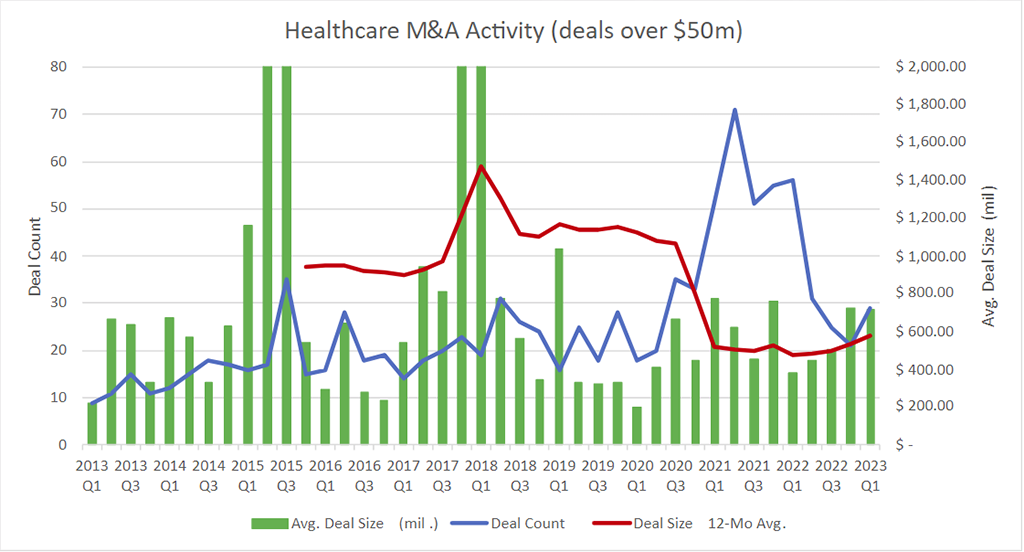
Key takeaway: Increased M&A activity should accelerate consolidation across the healthcare sector. To remain competitive, explore scaling your practice with greater technology, additional cost management processes and additional payment options to reduce receivables to enhance margins and cash flow.
Disclosures
Investment advisory services are offered by Aprio Wealth Management, LLC, a Securities and Exchange Commission Registered Investment Advisor. Opinions expressed are as of the current date (May 15, 2023) and subject to change without notice. Aprio Wealth Management, LLC shall not be responsible for any trading decisions, damages, or other losses resulting from, or related to, the information, data, analyses or opinions contained herein or their use, which do not constitute investment advice, are provided as of the date written, are provided solely for informational purposes and therefore are not an offer to buy or sell a security. This commentary is for informational purposes only and has not been tailored to suit any individual. References to specific securities or investment options should not be considered an offer to purchase or sell that specific investment.
This commentary contains certain forward-looking statements. Forward-looking statements involve known and unknown risks, uncertainties and other factors which may cause the actual results to differ materially and/or substantially from any future results, performance or achievements expressed or implied by those projected in the forward-looking statements for any reason.
No graph, chart, or formula in this presentation can be used in and of itself to determine which securities to buy or sell, when to buy or sell securities, whether to invest using this investment strategy, or whether to engage Aprio Wealth Management, LLC’s investment advisory services.
Investments in securities are subject to investment risk, including possible loss of principal. Prices of securities may fluctuate from time to time and may even become valueless. Any securities mentioned in this commentary are not FDIC-insured, may lose value, and are not guaranteed by a bank or other financial institution. Before making any investment decision, investors should read and consider all the relevant investment product information. Investors should seriously consider if the investment is suitable for them by referencing their own financial position, investment objectives, and risk profile before making any investment decision. There can be no assurance that any financial strategy will be successful.
Securities offered through Purshe Kaplan Sterling Investments. Member FINRA/SIPC. Investment Advisory Services offered through Aprio Wealth Management, LLC, a registered investment advisor. Aprio Wealth Management, LLC and the Aprio Group of Companies are not affiliated with Purshe Kaplan Sterling Investments.
Stay informed with Aprio.
Get industry news and leading insights delivered straight to your inbox.
Recent Articles
About the Author
Simeon Wallis
Simeon is the Chief Investment Officer of Aprio Wealth Management and the Director of Aprio Family Office. Simeon brings two decades of professional investing experience in publicly traded and privately held companies, as well as senior-level operating and strategy consulting experiences.
Scott Rittenberg
Scott is a Tax Partner on Aprio’s National Healthcare Practice team, where he advises dental and medical practice owners to help them deliver results and achieve their goals. With more than 30 years of public accounting experience, he specializes in strategic tax planning, cash flow and working capital management, profitability and compensation consulting, and succession planning.


